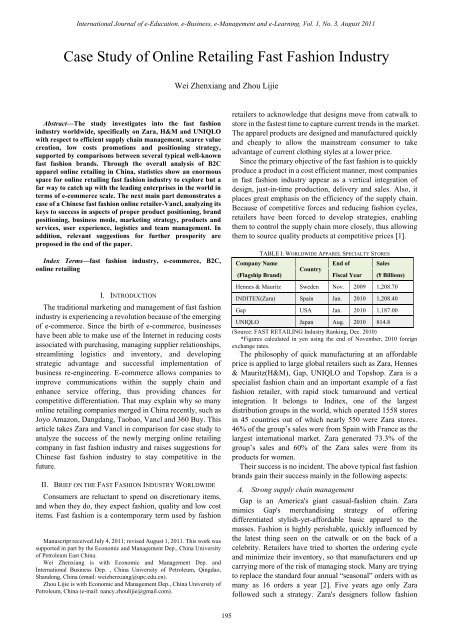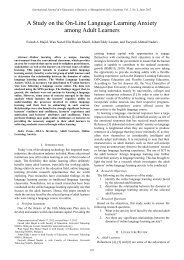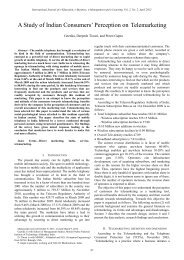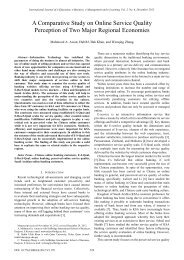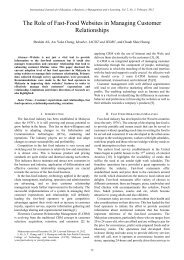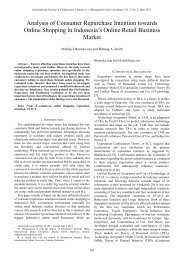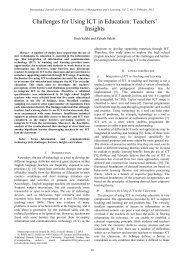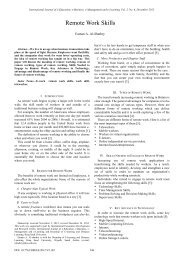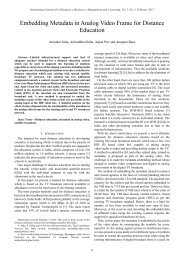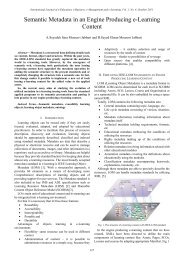Case Study of Online Retailing Fast Fashion Industry - ijeeee
Case Study of Online Retailing Fast Fashion Industry - ijeeee
Case Study of Online Retailing Fast Fashion Industry - ijeeee
Create successful ePaper yourself
Turn your PDF publications into a flip-book with our unique Google optimized e-Paper software.
International Journal <strong>of</strong> e-Education, e-Business, e-Management and e-Learning, Vol. 1, No. 3, August 2011<br />
<strong>Case</strong> <strong>Study</strong> <strong>of</strong> <strong>Online</strong> <strong>Retailing</strong> <strong>Fast</strong> <strong>Fashion</strong> <strong>Industry</strong><br />
�<br />
Abstract—The study investigates into the fast fashion<br />
industry worldwide, specifically on Zara, H&M and UNIQLO<br />
with respect to efficient supply chain management, scarce value<br />
creation, low costs promotions and positioning strategy,<br />
supported by comparisons between several typical well-known<br />
fast fashion brands. Through the overall analysis <strong>of</strong> B2C<br />
apparel online retailing in China, statistics show an enormous<br />
space for online retailing fast fashion industry to explore but a<br />
far way to catch up with the leading enterprises in the world in<br />
terms <strong>of</strong> e-commerce scale. The next main part demonstrates a<br />
case <strong>of</strong> a Chinese fast fashion online retailer-Vancl, analyzing its<br />
keys to success in aspects <strong>of</strong> proper product positioning, brand<br />
positioning, business mode, marketing strategy, products and<br />
services, user experience, logistics and team management. In<br />
addition, relevant suggestions for further prosperity are<br />
proposed in the end <strong>of</strong> the paper.<br />
Index Terms—fast fashion industry, e-commerce, B2C,<br />
online retailing<br />
I. INTRODUCTION<br />
The traditional marketing and management <strong>of</strong> fast fashion<br />
industry is experiencing a revolution because <strong>of</strong> the emerging<br />
<strong>of</strong> e-commerce. Since the birth <strong>of</strong> e-commerce, businesses<br />
have been able to make use <strong>of</strong> the Internet in reducing costs<br />
associated with purchasing, managing supplier relationships,<br />
streamlining logistics and inventory, and developing<br />
strategic advantage and successful implementation <strong>of</strong><br />
business re-engineering. E-commerce allows companies to<br />
improve communications within the supply chain and<br />
enhance service <strong>of</strong>fering, thus providing chances for<br />
competitive differentiation. That may explain why so many<br />
online retailing companies merged in China recently, such as<br />
Joyo Amazon, Dangdang, Taobao, Vancl and 360 Buy. This<br />
article takes Zara and Vancl in comparison for case study to<br />
analyze the success <strong>of</strong> the newly merging online retailing<br />
company in fast fashion industry and raises suggestions for<br />
Chinese fast fashion industry to stay competitive in the<br />
future.<br />
II. BRIEF ON THE FAST FASHION INDUSTRY WORLDWIDE<br />
Consumers are reluctant to spend on discretionary items,<br />
and when they do, they expect fashion, quality and low cost<br />
items. <strong>Fast</strong> fashion is a contemporary term used by fashion<br />
Manuscript received July 4, 2011; revised August 1, 2011. This work was<br />
supported in part by the Economic and Management Dep., China University<br />
<strong>of</strong> Petroleum East China.<br />
Wei Zhenxiang is with Economic and Management Dep. and<br />
International Business Dep. , China University <strong>of</strong> Petroleum, Qingdao,<br />
Shandong, China (email: weizhenxiang@upc.edu.cn).<br />
Zhou Lijie is with Economic and Management Dep., China University <strong>of</strong><br />
Petroleum, China (e-mail: nancy.zhoulijie@gmail.com).<br />
Wei Zhenxiang and Zhou Lijie<br />
195<br />
retailers to acknowledge that designs move from catwalk to<br />
store in the fastest time to capture current trends in the market.<br />
The apparel products are designed and manufactured quickly<br />
and cheaply to allow the mainstream consumer to take<br />
advantage <strong>of</strong> current clothing styles at a lower price.<br />
Since the primary objective <strong>of</strong> the fast fashion is to quickly<br />
produce a product in a cost efficient manner, most companies<br />
in fast fashion industry appear as a vertical integration <strong>of</strong><br />
design, just-in-time production, delivery and sales. Also, it<br />
places great emphasis on the efficiency <strong>of</strong> the supply chain.<br />
Because <strong>of</strong> competitive forces and reducing fashion cycles,<br />
retailers have been forced to develop strategies, enabling<br />
them to control the supply chain more closely, thus allowing<br />
them to source quality products at competitive prices [1].<br />
TABLE I: WORLDWIDE APPAREL SPECIALTY STORES<br />
Company Name<br />
End <strong>of</strong> Sales<br />
Country<br />
(Flagship Brand) Fiscal Year (¥ Billions)<br />
Hennes & Mauritz Sweden Nov. 2009 1,208.70<br />
INDITEX(Zara) Spain Jan. 2010 1,208.40<br />
Gap USA Jan. 2010 1,187.00<br />
UNIQLO Japan Aug. 2010 814.8<br />
(Source: FAST RETAILING <strong>Industry</strong> Ranking, Dec. 2010)<br />
*Figures calculated in yen using the end <strong>of</strong> November, 2010 foreign<br />
exchange rates.<br />
The philosophy <strong>of</strong> quick manufacturing at an affordable<br />
price is applied to large global retailers such as Zara, Hennes<br />
& Mauritz(H&M), Gap, UNIQLO and Topshop. Zara is a<br />
specialist fashion chain and an important example <strong>of</strong> a fast<br />
fashion retailer, with rapid stock turnaround and vertical<br />
integration. It belongs to Inditex, one <strong>of</strong> the largest<br />
distribution groups in the world, which operated 1558 stores<br />
in 45 countries out <strong>of</strong> which nearly 550 were Zara stores.<br />
46% <strong>of</strong> the group‘s sales were from Spain with France as the<br />
largest international market. Zara generated 73.3% <strong>of</strong> the<br />
group‘s sales and 60% <strong>of</strong> the Zara sales were from its<br />
products for women.<br />
Their success is no incident. The above typical fast fashion<br />
brands gain their success mainly in the following aspects:<br />
A. Strong supply chain management<br />
Gap is an America's giant casual-fashion chain. Zara<br />
mimics Gap's merchandising strategy <strong>of</strong> <strong>of</strong>fering<br />
differentiated stylish-yet-affordable basic apparel to the<br />
masses. <strong>Fashion</strong> is highly perishable, quickly influenced by<br />
the latest thing seen on the catwalk or on the back <strong>of</strong> a<br />
celebrity. Retailers have tried to shorten the ordering cycle<br />
and minimize their inventory, so that manufacturers end up<br />
carrying more <strong>of</strong> the risk <strong>of</strong> managing stock. Many are trying<br />
to replace the standard four annual ―seasonal‖ orders with as<br />
many as 16 orders a year [2]. Five years ago only Zara<br />
followed such a strategy. Zara's designers follow fashion
International Journal <strong>of</strong> e-Education, e-Business, e-Management and e-Learning, Vol. 1, No. 3, August 2011<br />
trends closely. In general, a typical clothing company<br />
manufacturing in Asia could take six to nine months to get a<br />
new design into the shops. With a strong logistics system, an<br />
entirely new Zara garment takes about five weeks from<br />
design to delivery, while a new version <strong>of</strong> an existing model<br />
can be in the shops within two weeks. In a typical year, Zara<br />
launches some 11,000 new items, compared with the<br />
2,000-4,000 from companies like H&M or Gap.<br />
B. Scarce Value Creation<br />
Apart from the supply chain management, contributing to<br />
Zara's success is its focus on a limited range, basic shapes and<br />
small sizes, so that it deals with a rather narrow product range.<br />
Zara avoids over supply. Although some stock is replenished,<br />
its clothing, for both men and women, is deliberately made in<br />
small batches. This helps create a scarce value. It also keeps<br />
shops looking fresh and reduces markdowns. At Zara, the<br />
number <strong>of</strong> items that end up in a sale is about half the industry<br />
average. The result is that Zara's production cycles are much<br />
faster than its rival, H&M.<br />
C. Low Costs on promotions<br />
A well-known brand takes a great deal <strong>of</strong> time to<br />
create—partly because, unlike manufacturers, whose<br />
products are promoted by shops, retailers must do all the<br />
promoting themselves. To compete with Gap, Zara keeps its<br />
inventories very lean, meaning it avoids pr<strong>of</strong>it-damaging<br />
promotions and sales. It avoids advertising in order to cut<br />
down on costs. In consideration <strong>of</strong> promotion, Zara is<br />
parsimonious with advertising and discounts. It spends just<br />
0.3% <strong>of</strong> sales on ads, compared with the 3-4% typically spent<br />
by rivals.<br />
D. Flexible brand positioning strategy<br />
Entering in the Chinese market in 2002, UNIQLO<br />
originally positioned itself to deliver good quality clothes to<br />
all population at a low price. However, the low cost strategy<br />
did not drive to success. In 2006, UNIQLO switched its<br />
strategic direction to target urban middle class, providing<br />
apparels which are easy to mix and match with other brands.<br />
New strategy led to 6 times growth in sales in the Chinese<br />
market from 2006 to 2008. Major customer groups are aged<br />
from 20 to 30. Both online and <strong>of</strong>fline channel experienced a<br />
fast growth in 2009. The online shop was opened on Taobao<br />
platform in April 2009. The number <strong>of</strong> physical shops<br />
reached 34 in China, and 26 <strong>of</strong> them are built in 2009.<br />
<strong>Online</strong> fashion sales, however, are proving remarkably<br />
resilient. Zara and H&M are two more in a long line <strong>of</strong><br />
fashion stores that have moved into the online retail market.<br />
Neither H&M nor Inditex disclose what proportion <strong>of</strong> sales<br />
comes from their online outfits. U.S. rival Gap Inc. generated<br />
about 8% <strong>of</strong> its Gap-branded sales in the U.S. on the Web.<br />
Above all, apparel specialties worldwide tend to gain right<br />
balance between fashion, quality and price at the right time.<br />
III. AN OVERALL ANALYSIS ON TRANSACTION OF CHINESE<br />
ONLINE FASHION<br />
China‘s online retailing market value has been roughly<br />
doubling in value continuously for several years, and keeps<br />
showing a rapid pace <strong>of</strong> growth. Meanwhile, every six<br />
months the population <strong>of</strong> China‘s cyberspace increases by<br />
196<br />
about a third. The annual growth rate <strong>of</strong> the total online sales<br />
market reached 95.9% during the year 2004 to 2010, C2C<br />
included, compared to 87.4% <strong>of</strong> B2C over the same period.<br />
However, B2C has accelerated to become segment with the<br />
highest growth rate among the total internet transactions<br />
forms. Increasingly, confidence in retailers and payment<br />
methods, as well as more well-rounded information privacy<br />
policies are driving more consumers to shop online,<br />
especially towards those identifiable as bone fide companies.<br />
Fig. 1.Revenue Scale <strong>of</strong> B2C market in China<br />
(Source: ―2010 Chinese B2C Market Investigation‖, Zero2IPO Research<br />
Centre, 2010)<br />
As we can see in Fig.1, the transaction scale <strong>of</strong> Chinese<br />
e-commerce has grown steadily from 2004 to 2009, 57.1% <strong>of</strong><br />
which in terms <strong>of</strong> quantity is mainly engaged by apparel<br />
consumption(refer to Table II), indicating that the apparel<br />
industry in China provides an enormous space for<br />
e-commerce. On the basis <strong>of</strong> the figures gained in the<br />
previous years, IResearch estimates the prosperous future<br />
trend <strong>of</strong> Chinese apparel e-commerce transaction scale.<br />
One difference between <strong>of</strong>fline and online shopping is that<br />
physical supermarket in the neighborhood without price<br />
advantages or product differentiation can still survive by its<br />
convenience. However, online retailers are easily neglected if<br />
product distinction or further values are not provided.<br />
Moreover, purchasing online involves less opportunity costs<br />
relative to <strong>of</strong>fline shopping because price comparison<br />
between several online malls can be realized within a second.<br />
This aggravates the price competition and lead to squeezed<br />
pr<strong>of</strong>its in the market.<br />
For existing bricks-and-mortar retail companies, online<br />
sales are creating new avenues to new consumers in regions<br />
<strong>of</strong> China where they have not yet managed to cover. Without<br />
the need to invest in the building physical store chains or<br />
management <strong>of</strong> franchisees, online retailers financially bear<br />
less. What does lag, and stalls the more rapid growth <strong>of</strong><br />
retailer penetration across more <strong>of</strong> the country via the<br />
Internet, is the lack <strong>of</strong> product delivery infrastructure and<br />
on-going weaknesses in the transaction clearing<br />
infrastructure.<br />
For emerging online-only retailers, there is the prospect <strong>of</strong><br />
creating the kind <strong>of</strong> strong competition with the traditional<br />
retailers that can act as a strong lever for increasing capital<br />
investment, or negotiating into partnerships with the<br />
traditional retailers, where established online retail expertise<br />
and technologies are hugely valuable.
TABLE II: RANKING OF BEST SOLD ITEMS IN CHINA OVER INTERNET<br />
Ranking Items<br />
Purchased by %<br />
<strong>of</strong> <strong>Online</strong> Buyers<br />
1 Apparel, accessories and footwear 57.1%<br />
2 Books, CDs and DVDs 46.0%<br />
3 Cosmetics 40.6%<br />
4 Electronics (Cameras, MP3) 35.4%<br />
5<br />
Rechargeable cards for<br />
games and cell phones<br />
32.1%<br />
6 Home decorations 29.2%<br />
7<br />
Cell phones and electronic<br />
accessories<br />
27.4%<br />
8 Gifts and toys 24.7%<br />
9 Computer, laptops and hardware 23.0%<br />
10 Home appliances 22.1%<br />
11<br />
Jewelries, watches, accessories,<br />
glasses<br />
20.3%<br />
12 Foods 19.7%<br />
13 Maternity and baby products 11.5%<br />
14<br />
White goods(fridges,<br />
washing machines, air<br />
conditionings)<br />
2.9%<br />
15 Others 2.0%<br />
(Source: IResearch, March 13, 2009)<br />
The online shopping industry is going through a period <strong>of</strong><br />
fast growth and turbulence with fierce competition. Major<br />
players compete to gain a controlling share <strong>of</strong> the market in<br />
all aspects. Common promotional activities including price<br />
discounts and shipping cost reductions are widely used to<br />
gain customers. As one online shopping mall takes initiatives<br />
on sales promotion, competing firms follow very shortly.<br />
Automatic price comparison system is adopted by top players<br />
to <strong>of</strong>fer best prices among competitors and modify<br />
automatically online price to a comparable level if rivalry<br />
companies reduce their prices. Due to the intense price<br />
competition, online buyers are swayed by lower prices with<br />
relatively low brand loyalty.<br />
<strong>Online</strong> fashion has had a ‗budget‘ reputation from the<br />
beginning. But there are significant costs for online retailers<br />
in logistics and the costs <strong>of</strong> handling returns. These increased<br />
costs will have a high impact on the retailer‘s low margin,<br />
high quantity business model. Also, the average delivery<br />
costs, to be paid by the consumer, can easily be as high as, or<br />
even higher, as the price <strong>of</strong> a single piece <strong>of</strong> budget clothing<br />
[3]. Consequently, clothing manufacturers and retailers must<br />
establish a good feedback system and improve levels <strong>of</strong><br />
supply chain management, logistics, product identification,<br />
standardization and automation.<br />
Different from traditional channels, e-commerce appeals<br />
as a significant move to target more customers for Chinese<br />
apparel industry. Table II shows the revenue <strong>of</strong> several major<br />
apparel online retailers in China from the year 2007 to 2009.<br />
TABLEIII: REVENUE OF TRANSACTIONS OF MAJOR APPAREL ONLINE<br />
RETAILERS IN CHINA<br />
Brand<br />
Name<br />
International Journal <strong>of</strong> e-Education, e-Business, e-Management and e-Learning, Vol. 1, No. 3, August 2011<br />
Founded<br />
Year<br />
Revenue (¥bn)<br />
2007 2008 2009<br />
Vancl 2007 / 0.88 1.22<br />
Masomaso 2008 0.02 0.05 0.08<br />
Moonbasa 2006 0.02 0.06 0.1<br />
M18 1996 0.11 0.1 0.35<br />
(Source: ―2010 Chinese B2C Market Investigation‖, Zero2IPO Research<br />
Centre, 2010)<br />
197<br />
<strong>Online</strong> retailers compete with all means for<br />
winner-takes-all markets in the long run. Most large scaled<br />
online B2C retailers still struggle to become pr<strong>of</strong>itable due to<br />
lack <strong>of</strong> scale economies; therefore, inability to achieved<br />
reduced costs per unit. Meanwhile, new comers backed by<br />
venture capitalists enter this market to a great extend. A<br />
number <strong>of</strong> young established specialist retailers emerge by<br />
<strong>of</strong>fering specific product categories, like online specialists in<br />
food, clothes, and shoes.<br />
The apparel retailing industry is investing large sums <strong>of</strong><br />
money in the Internet technology, delivery infrastructure and<br />
transaction systems which will give allowance to secure a<br />
significant slice <strong>of</strong> this market into the future. According to a<br />
survey conducted by the China Internet Network Information<br />
Center (CINIC), major factors affecting online purchasing<br />
decisions involve price and quality <strong>of</strong> goods, brand<br />
recognition, after-sale services, customers‘ feedbacks, speed<br />
and quality <strong>of</strong> delivery, promotions, advertisements and user<br />
interface <strong>of</strong> websites.<br />
IV. CASE STUDY OF CHINESE FAST FASHION ONLINE<br />
RETAILING—VANCL<br />
Vancl, rated as the largest online and phone-based<br />
own-brand apparel retailer in China, was formally<br />
established in 2007, led the Deloitte Technology <strong>Fast</strong> 500<br />
Asia Pacific 2009 ranking with a three-year revenue growth<br />
rate <strong>of</strong> 29,577%. It took over its rival---PPG in terms <strong>of</strong> sales<br />
only 5 months after its establishment, creating a commercial<br />
marketing myth in the Chinese garment industry [4]. Vancl<br />
has fast become China‘s first (online) business-to-consumer<br />
brand for men‘s clothing. Through a series <strong>of</strong> brand and<br />
product positioning, Vancl successfully extended the range<br />
<strong>of</strong> products from men‘s shirts to POLO shirts, pants, shoes<br />
and other clothing and household goods which mainly target<br />
at the white collar workers and students. In 2009, the<br />
company continued to expand its product lines by entering<br />
the women‘s clothing market and by marketing footwear.<br />
Vancl has quickly made itself a familiar name to netizens in<br />
China under a unique marketing model using online<br />
advertisements. The company sells more than 30,000 items<br />
ranging from shirts and shoes to home textiles. The company<br />
currently has more than 800 employees.<br />
According to "2010 China's <strong>Online</strong> Shopping Market<br />
Monitoring Report" raised by IResearch Consulting Group,<br />
Vancl took a share <strong>of</strong> 5.3% <strong>of</strong> independent sales turnover <strong>of</strong><br />
Chinese B2C online shopping market in the 3rd quarter <strong>of</strong><br />
2008 and enjoyed 28.4% <strong>of</strong> the domestic apparel<br />
e-commerce share (as is shown in Fig.2) in 2009, thus<br />
ranking the top in the fast fashion online retailing in China.<br />
Sales <strong>of</strong> Vancl was recorded worth RMB 2 billion in 2010<br />
and expects the figure to grow to RMB 6 billion in 2011,<br />
according to Sohu report in Jan. 2011.<br />
Yet Vancl‘s success is no accident. It gained success<br />
primarily based on the proper product and brand positioning,<br />
B2C online direct-selling model, multiple channels<br />
promotion, high-quality products, fair price, efficient<br />
logistics, favorable user experience and good team<br />
management.
International Journal <strong>of</strong> e-Education, e-Business, e-Management and e-Learning, Vol. 1, No. 3, August 2011<br />
Fig. 2.Market Share <strong>of</strong> <strong>Online</strong> Retailers in China<br />
(Source: ―2009-2010 Chinese B2C Apparel Transaction Report‖, IResearch,<br />
2010)<br />
A. Product positioning-Men to Women<br />
What leads to success in the first place is Vancl‘s right<br />
choice <strong>of</strong> the first entry point into the market--- Men's shirts.<br />
Since users have indirect contact with the online products,<br />
Vancl must provide standardized products to improve<br />
customer satisfaction and try its best to meet needs <strong>of</strong> user<br />
experience. As criteria for men's shirts are relatively simple,<br />
shirts are easier to reach the requirement.<br />
Most <strong>of</strong> the time, shirts appear as a kind <strong>of</strong> essential<br />
clothing for men, resulting in a high demand in men's shirts.<br />
Trends <strong>of</strong> urban white-collar clients are subject to foreign<br />
influence. Men get used to wear a different shirt every day,<br />
thus increasing consumer demand in shirts, which provides<br />
Vancl a broad market.<br />
Most <strong>of</strong> men would haste in shopping, making the<br />
demands for shirts relatively simple. Thus, shirts may have<br />
similar designs but distinguish by patterns and colors.<br />
In view <strong>of</strong> the above characteristics <strong>of</strong> men's shirts<br />
consumer market, Vancl creates a model in full compliance<br />
with the consuming habits <strong>of</strong> men on shirts, while providing a<br />
more abundant and convenient option. According to the<br />
feedbacks <strong>of</strong> its customers, Vancl began to target at the<br />
women clothing later in 2009. Survey showed that over 70%<br />
<strong>of</strong> the visitors on Vancl website were female and apparently<br />
there exists a great need to promote women clothing.<br />
Currently, Vancl could make total revenue <strong>of</strong> around 10<br />
million Yuan every day.<br />
B. Brand positioning-Simple,Easy and Natural<br />
The brand name ―Vancl‖ means all customers are ordinary<br />
in Chinese. Vancl is always promoting a lifestyle: getting rid<br />
<strong>of</strong> a vanity <strong>of</strong> things and have a most decent and comfortable<br />
way <strong>of</strong> life. Vancl‘s slogan goes like ―Cotton style is the new<br />
formula <strong>of</strong> life‖. Clothes <strong>of</strong> it have common grounds namely<br />
simple, classic style, natural and environmental-friendly<br />
fabric and easy ways <strong>of</strong> cutting. And the company is trying to<br />
convey a value system to consumers, which is pursuing the<br />
brand in a liberate way, being in a style <strong>of</strong> low pr<strong>of</strong>ile and<br />
simple, seeking calm and elegance and focusing on the<br />
details. With a good brand positioning, Vancl gradually<br />
establishes a favorable corporate image and forms stable<br />
intangible assets.<br />
C. Business mode-B2C Direct Selling<br />
Vancl applies the B2C (Business to Customers) model for<br />
online retailing. It doesn‘t possess any fabrication plants or<br />
198<br />
any physical sales channels. Vancl‘s direct selling model<br />
mainly consists <strong>of</strong> raw material suppliers, garment processors,<br />
shopping sites and logistics. In this model, Apart from its<br />
brand's design and part <strong>of</strong> the logistic delivery, Vancl<br />
outsources the production process to OEM or other plants.<br />
Vancl sells goods directly through the website, phone orders<br />
and catalog mail, hence eliminating the need for the<br />
traditional maternity shops. Hence, consumers could enjoy a<br />
much lower price <strong>of</strong> commodity at Vancl than other<br />
conventional purchasing channels. That‘s how Vancl<br />
shortens the production cycle and save amounts <strong>of</strong> money on<br />
stock, leading to reduction in cost <strong>of</strong> products. Therefore,<br />
B2C online direct selling model could be regarded as one key<br />
ingredient <strong>of</strong> Vancl‘s success.<br />
D. Marketing Strategy-Ads in multiple channels<br />
Vancl attempted to deliver ads through various channels.<br />
Take network advertising for instance, Vancl‘s network<br />
media advertising is believed to be successful considering its<br />
depth, breadth and accuracy. Here are some tips in its<br />
marketing strategies:<br />
� Vancl makes use <strong>of</strong> large banners to cover the largest<br />
area on the page to attract attention when making<br />
advertisements on Sina, Tencent, Netease, Sohu and<br />
other portal websites in mainland China.<br />
� Ads are posted on the most popular and frequently<br />
visited mainstream communities, forums and some<br />
instant communication tools to achieve deep<br />
penetration <strong>of</strong> key target groups.<br />
� Vancl‘s pay per click advertisement operates just as<br />
Google AdWords and gives permission to sellers to<br />
bid on relevant keywords used by target audiences to<br />
search for desired products. Pay per click<br />
advertisements will mostly be shown on the right up<br />
side <strong>of</strong> the front-page.<br />
� The search engines keyword ads and content ads are<br />
utilized to seize the potential customers on the "long<br />
tail" [5].<br />
� Popular celebrities were once invited to be the image<br />
prolocutors <strong>of</strong> Vancl‘s products, arousing a ―Vancl<br />
introduction style‖ in the summer <strong>of</strong> 2010.<br />
Despite the amount <strong>of</strong> the ads, clear selling points, nice<br />
arrangement and high qualified pictures <strong>of</strong> ads play important<br />
role in catching the attention <strong>of</strong> consumers to some extent,<br />
thus enhancing sales simultaneously.<br />
There are many types <strong>of</strong> physical ads as well. Billboards <strong>of</strong><br />
Vancl are placed aside the passengers <strong>of</strong> subways and even<br />
on the buses in Beijing. Notably, all the products (accessories<br />
and packages included) would have an obvious print <strong>of</strong><br />
―Vancl‖ logo, making it easy for buyers‘ acquaintance to<br />
remember the brand name.<br />
With a wide range <strong>of</strong> strategies on publicity and promotion,<br />
Vancl is bound to win its market.<br />
E. High-quality products<br />
Vancl have greatly invested in the selection <strong>of</strong> suppliers in<br />
the upstream, the establishment <strong>of</strong> the tracking system and<br />
the introduction <strong>of</strong> the design team. Highly trained quality<br />
checking staff, usually stationed in the plant <strong>of</strong> OEM to<br />
monitor the entire production process and make product
sampling tests occasionally. Then dedicated quality control<br />
personnel would conduct a comprehensive examination<br />
towards the finished products stocked in the warehouse. Only<br />
the products that got passed the check <strong>of</strong> the appearance,<br />
cuffs, buttons, threads and other aspects could be sent to the<br />
warehouses.<br />
F. Fair price<br />
Vancl deems to provide good quality products with fair<br />
price. The most typical example is its famous ―VT‖<br />
requesting just29RMB. The T-shirts it <strong>of</strong>fers are all <strong>of</strong><br />
high-quality and dedicated designed by pr<strong>of</strong>essional<br />
designing team abroad. The same applies to its canvas shoes<br />
and shirts for men and women. For top consumers, Vancl<br />
provides Vjia (V+) products to satisfy their consuming needs.<br />
G. Efficient logistics<br />
International Journal <strong>of</strong> e-Education, e-Business, e-Management and e-Learning, Vol. 1, No. 3, August 2011<br />
Most online retailing companies would naturally outsource<br />
logistic to TLC so as to lower down the total operation cost<br />
[6]. But who should be blamed for and pay for the loss <strong>of</strong><br />
customers in case that delivery was delayed? There suppose<br />
to be no definite answer in most cases. To solve the problem,<br />
Vancl combined the wholly-owned logistic department and<br />
third party partners, with the order tracking system ensuring<br />
the company receives fewer complaints for delivery.<br />
H. Favorable user experience<br />
Vancl has improved a lot in its user experience services.<br />
Vancl firstly activated a service <strong>of</strong> trial before payment and<br />
cash on delivery (C.O.D). And customers would have the<br />
right to reject purchase without any reason within 30 days in<br />
the validation <strong>of</strong> orders [7]. Additionally, the site <strong>of</strong>fers<br />
enhanced services such as tracking <strong>of</strong> goods and management<br />
<strong>of</strong> inventory. Apart from that, Vancl provides spaces for<br />
customers to comment on the goods they purchased as<br />
feedbacks on the website. In order to better fit the needs <strong>of</strong><br />
customers, the company has bought a 3D virtual model<br />
system and is planning to develop its own trial-online<br />
animation system based on that.<br />
I. Good team Management<br />
It is the team management, which forms the fundamental<br />
difference among other direct marketing online projects,<br />
plays a key role in the whole project in Vancl. CEO-Chen<br />
Nian, who was also the founder and former executive vice<br />
president <strong>of</strong> Joyo Amazon, led the following job-hopping<br />
members form the core team that later became backbones <strong>of</strong><br />
Vancl. Their experience <strong>of</strong> network marketing, an accurate<br />
grasp <strong>of</strong> China's Internet environment and the actual<br />
operation experience <strong>of</strong> B2C e-commerce are the best<br />
explanations for the Vancl miracle [8].<br />
V. SUGGESTIONS FOR VANCL‘S FUTURE PROSPER<br />
A. Strengthen supply chain integration and supervision<br />
It has always been a hot potato as how to ensure the quality<br />
<strong>of</strong> clothing from upstream suppliers as well as the quality <strong>of</strong><br />
delivery service provided by the TPL companies. The most<br />
effective way to solve it is to strengthen the supervision and<br />
control <strong>of</strong> all aspects during the process. There should be<br />
appropriate supervision in the process from the fabric<br />
199<br />
transported into the plant, onto various assembly lines and to<br />
final order fulfillment. Whether outsourcing quality<br />
supervision to a third party or establishing its own monitoring<br />
team, Vancl must strengthen the integration <strong>of</strong> the supply<br />
chain and all aspects <strong>of</strong> supervision during the process from<br />
production to the final delivery. It could establish relevant<br />
integrity systems and service quality system for the<br />
cooperative enterprise, in which it judges the integrity and<br />
quality <strong>of</strong> service companies according to their business<br />
performance, and selects the more suitable enterprises to<br />
cooperate for further development.<br />
B. Enhance quality and service <strong>of</strong> products<br />
Quality is quite crucial towards the enterprise itself. To<br />
guarantee the quality <strong>of</strong> goods sold online, Vancl has to seek<br />
creditworthy channels for manufacturing. Feedbacks <strong>of</strong><br />
consumers could also reflect the quality <strong>of</strong> goods.<br />
Consequently, greater emphasis should be placed on user<br />
experience services. Vancl could devote to designing<br />
user-friendly page and interactive forum so as to take<br />
advantage <strong>of</strong> the feedbacks to ensure that consumers could<br />
acquire a variety <strong>of</strong> information about products either<br />
displayed on the website or the catalogue [9]. Meanwhile, the<br />
website must refresh its information regularly and in time to<br />
inform consumers about its new fashion and stock.<br />
C. Innovate and enhance core competitiveness constantly<br />
Large numbers <strong>of</strong> domestic clothing market or network<br />
marketing companies are founded to follow the steps <strong>of</strong><br />
Vancl recently. And the traditional clothing manufacturers<br />
rapidly transformed to e-commerce platform, such as the<br />
Saint Angelo, Shanshan, Youngor and so on. Therefore,<br />
Vancl should continue to innovate to meet consumer<br />
demands to lead the industry [10]. On the one hand,<br />
innovation helps to build its powerful competitive<br />
advantages, making it difficult for competitors to surpass. On<br />
the other hand, Vancl‘s endeavor for innovation would attract<br />
more people's attention in the entire industry, which helps to<br />
enhance its fame in the future.<br />
Products and direct sales model could be easily imitated by<br />
others. Yet, execution <strong>of</strong> team is exception. <strong>Fast</strong> fashion B2C<br />
industry changes fast so that the enterprise couldn‘t just rely<br />
on the previous experience <strong>of</strong> the team. Thus, Vancl has to<br />
build a learning team to enhance its core competitiveness and<br />
provide the learning team a chance to manage and operate the<br />
company, hence allowing the enterprise to turn into a<br />
learning-oriented enterprise, so as to ensure that businesses<br />
compete in an invincible position in the future [11].<br />
D. Assure balance between cost and quality <strong>of</strong> delivery<br />
Most online customers are highly price sensitive. Freights<br />
can account for a large percentage <strong>of</strong> the total cost which<br />
impedes buyers from purchasing online. If online total costs<br />
including delivery fees exceed <strong>of</strong>fline purchases, there is<br />
nearly zero incentive to shop online. Therefore, domestic<br />
logistic providers are considerably more popular than<br />
international logistic companies for the cost reason. Some<br />
online stores cover delivery costs for customers in major<br />
cities as their sales promotions. Covering delivery costs is<br />
feasible for sellers <strong>of</strong> fast fashion industry.<br />
<strong>Online</strong> seller should consider delivery quality including
International Journal <strong>of</strong> e-Education, e-Business, e-Management and e-Learning, Vol. 1, No. 3, August 2011<br />
speed, probability <strong>of</strong> damaged and missing goods, regional<br />
coverage, service, price, and complaint management. <strong>Online</strong><br />
platform and online retailers also creates standardized<br />
selection criteria, like secret spontaneous control on logistic<br />
companies to provide better online experience for customers.<br />
Furthermore, the service <strong>of</strong> delivery to neighboring<br />
convenience stores has been tested in certain cities. In the<br />
service areas, customers are able to pick up their parcels in<br />
nearby convenience stores. This provides more delivery<br />
choices and convenience to online customers. It is expected<br />
that the more delicate services will be <strong>of</strong>fered and related<br />
logistic problem will be improved in the future.<br />
<strong>Online</strong> sellers need to assure the balance between cost and<br />
quality. It is crucial to cooperate with several logistic<br />
providers and reach a full coverage <strong>of</strong> target customer groups.<br />
Firms with larger delivery quantities, like UNIQLO, can set<br />
high partner selection standards and reach mutually agreed<br />
contracts with delivery companies.<br />
E. Build strong brand credibility<br />
<strong>Fast</strong> fashion consumption can be also reckoned as spiritual<br />
consumption, core spirit <strong>of</strong> which is embodied in the brand.<br />
Customer loyalty will be established afterwards once the<br />
brand is established [12]. Otherwise, it is impossible for<br />
consumers to trust the brand. PPG's failure lies in the facts<br />
that it paid attention to innovative business models, while<br />
ignoring to form strong barriers for its rivals using brand and<br />
the real core competitiveness relying on brands. Vancl<br />
definitely should learn the lesson and enhance its brand<br />
management in the future, paying every effort and operate<br />
carefully in the market research, product positioning and<br />
design, advertising and so on. Only through this way could<br />
Vancl build strong brand credibility.<br />
REFERENCES<br />
[1] G. Margaret Bruce, Lucy Daly, "Innovative process in E-commerce<br />
fashion supply chains", Innovative Quick Response Programs in<br />
Logistics and Supply Chain Management, pp. 227-241, 2010.<br />
200<br />
[2] Bart L. MacCarthy and P.G.S.A. Jayarathne. <strong>Fast</strong> <strong>Fashion</strong>: Achieving<br />
Global Quick Response (GQR) in the Internationally Dispersed<br />
Clothing <strong>Industry</strong>. Innovative Quick Response Programs in Logistics<br />
and Supply Chain Management, 2010.<br />
[3] International Handbooks on Information Systems, 2010Malcolm<br />
Newbery and Karlynne ter Meulen. Tomorrow‘s clothing retail: sectors,<br />
markets and routes – forecasts to 2016. Just-style, June 2010.<br />
[4] Wu Xiaobo, Bai Xubo,"From PPG to Vancl: Business Model Evolution<br />
<strong>of</strong> <strong>Online</strong> Clothing <strong>Retailing</strong>", Journal <strong>of</strong> Management <strong>Case</strong> Studies,<br />
vol.3, pp. 403-414, Oct. 2010.<br />
[5] Liu Zhijian, "Research on the Cyber Marketing Strategies on basis <strong>of</strong><br />
'the Long Tail Theory'", Market Modernization, vol. 567, pp 108, Feb.<br />
2009.<br />
[6] G. Heinemmann, C. Schwarzl, "New <strong>Online</strong> <strong>Retailing</strong>", pp. 187-209.<br />
[7] Zhu Ran, "Why could Vancl develop so fast——research on the hints<br />
Vancl brought for online retailing apparel industry", Business Strategy<br />
<strong>Case</strong> <strong>Study</strong>, pp. 64-66, 2009.<br />
[8] Hao Ran, "Vancl: Say goodbye to PPG",New Economy Guide, vol.<br />
11, pp. 56-57, 2009.<br />
[9] Jakob Nielsen, Rolf Molich, Carolyn Snyder, Susan Farrell,<br />
"E-commerce User Experience Search", Nielsen Norman Group, 2000.<br />
[10] Ramnath K. Chellappa, Raymond G. Sin, "Personalization versus<br />
Privacy: An Empirical Examination <strong>of</strong> the <strong>Online</strong> Consumer's<br />
Dilemma", Information Technology and Management, vol. 6, pp.<br />
181-202, 2005.<br />
[11] Lei Peili, Wen Bo, Wu Jian, "Exploration towards Management<br />
Patterns <strong>of</strong> Chinese Garment <strong>Industry</strong>—Basis on Vancl Marketing<br />
<strong>Case</strong>", Economic Research Guide, vol. 83, pp. 166-169, 2010.<br />
[12] Samuel Otim, Varun Grover, "E-commerce: a brand names curse",<br />
Electron Markets, vol. 20, pp. 147-160, May 2010.<br />
Wei Zhenxiang is a pr<strong>of</strong>essor and post-graduate supervisor at the Economic<br />
and Management Dep. and the dean <strong>of</strong> International Business Dep. <strong>of</strong> China<br />
University <strong>of</strong> Petroleum (East China), Qingdao, Shandong, PRC. Her<br />
research mainly covers study <strong>of</strong> Chinese income gap, Green GDP,<br />
fluctuation <strong>of</strong> price <strong>of</strong> Corns in China and Yellow River Delta research<br />
project. Contact her via weizhenxiang@upc.edu.cn.<br />
Zhou Lijie received BSc (2006) from the Economic and Management Dep.<br />
<strong>of</strong> China University <strong>of</strong> Petroleum (CUP). And she is currently a<br />
post-graduate candidate <strong>of</strong> CUP in Business Administration, particularly in<br />
strategic management <strong>of</strong> enterprises. She has experienced the regional<br />
cooperation <strong>of</strong> Yellow River Delta research program and Cost Management<br />
<strong>of</strong> Supply Chain project from 2009 to 2011. Contact her via<br />
nancy.zhoulijie@gmail.com.


